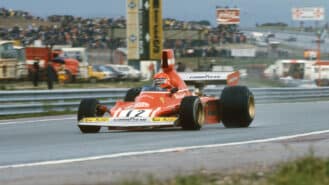‘Don’t expect anything more from Honda this year,’ was the message going out post-Japan following Fernando Alonso’s incendiary radio remarks about his “GP2 engine”. There has finally come the public acceptance from Honda that the big step-change in performance is not going to occur this year.

The turbo’s compressor is too small – part of that ‘size zero’ concept – and cannot be made to run fast enough to compensate in terms of creating enough heat to give the ersH something to work with. But whether the breakthrough even comes next season could depend upon what happens with the engine homologation regulations. As things currently stand, the engine token system reverts in 2016 to how it was in 2014. i.e. tokens cannot be spent during the season.

If the new Honda compressor – on which the whole competitiveness of the engine essentially relies – is not ready in time for the homologation date of February 28, McLaren-Honda potentially faces another full season with the current inadequately-dimensioned compressor.
The whole concept of the McLaren-Honda MP4-30 was based around a tiny rear end and it is without doubt the most tightly dimensioned of all the 2015 cars at the rear. This creates the potential for a significant aerodynamic advantage. The more tightly-waisted that coke bottle profile of the lower bodywork can be made, the faster the air will be induced into passing over the downforce-generating devices at the back of the car. The faster the air over the ‘brake ducts’ and inside the rear tyres, over the top of the diffuser (drawing harder on the air coming through the diffuser), the more downforce will be created.
The most obvious route to miniaturisation of the whole engine/turbo package was to make the compressor smaller. Like Mercedes, Honda opted to split the turbine from the compressor but stopped short of moving the compressor to the very front of the engine, where the Merc unit resides. Instead, it was made small enough to sit within the vee of the engine. This necessarily limited its power-producing – and therefore heat-generating – potential, but only if it ran at the same speed as a conventional compressor.
Honda was confident it could spin the turbine and compressor and the shaft that links them at speeds well in excess of 130,000rpm. At this speed it would produce comparable power and heat to the bigger conventional compressors in the other engines which were turning at less than 120,000rpm. It would be a way of Honda and McLaren getting to have their cake and eating it, with smaller size but comparable power.

It was a nice idea, but was obviously predicated on Honda being able to achieve something that no-one else had yet succeeded in doing. It was confident it could do so, but early testing revealed this to be an optimistic belief. Run at anything like the speeds needed to achieve comparable power, the turbine/compressor would either destroy itself or the ersH unit that sits between the turbine and compressor. To get it all to survive, the unit had to be limited to speeds no higher than those of a conventionally-sized unit.
For the first few races of the year there were further limitations, with vital sensors frying within the tight confines of the bodywork. So the compressor speed had to be limited yet further to keep the heat down below the crucial sensor-frying threshold. In this type of engine, the penalty for that is compounded, for not only are you generating less turbo boost, but limiting the generation of heat means that less heat is recovered by the ersH.
In the first few races – and at later ones on tracks where the ersH gets a hard workout – it was limited to around 35 per cent of its potential ersH power. Which essentially meant, as an average, it was contributing around 60bhp instead of 160bhp.
When Yasuhisa Arai, the beleaguered Honda F1 boss, spoke a couple of months ago about his engine being “more powerful than the Renault,” he was referring only to the internal combustion engine. Not the combination of that with the ersH. Even if the IC engine itself is marginally more potent than Renault’s, its total IC + ers falls a long way short.

The original hope was that the limitations to the compressor speed could be overcome during the season, and with that would come a step change in performance. It has not been possible to achieve. Honda is now flat out on a new design of compressor – still smaller than the others but with an improved design it hopes will allow those high rotation speeds.
Murmurings from inside suggest it’s going to be extremely difficult to ready it in time for the February 28 homologation date. There are rumours of another less ambitious – bigger – compressor design being done unofficially by a small skunkworks group within the company, which could be substituted. Even if this is true, it obviously would have very significant repercussions on the packaging of the car.
This year – after Ferrari spotted a loophole in the wording of the regulations – engine development tokens have been allowed to be spent during the season. That loophole was closed down by the FIA for 2016 onwards, when it reverts back to the original interpretation. That’s how things stand at the moment, at least. For that to be changed and to continue with the 2015 interpretation would require the unanimous consent of all the manufacturers.
Ferrari would like that and so, almost certainly under the circumstances, would Honda and probably Renault too. But Mercedes – which has already debuted what is essentially its 2016 engine (at Monza) to get some mileage on it before finalising the spec for February 28 – might not.
If there were to be another season of Honda humiliation, finding itself unable to incorporate the upgrades it had readied, the implications could get pretty serious for all concerned.









